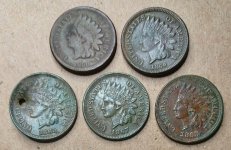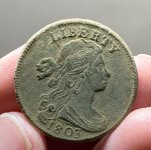Gypsy Heart
Gold Member
In 1682 French explorers sailed down the Mississippi River from the north and claimed for France all that territory drained by the river, and gave it the name Louisiana honoring King Louis XIV of France. Coochie Brake lay within that territory.
Coochie Brake is located in the southwestern part of what is now Winn Parish, Louisiana, about three miles from the community of Atlanta, a tract of approximately 800 acres of what could be called a "natural phenomenon," totally unrelated to the surrounding terrain. The spot is believed by some to be the result of a gigantic upheaval thousands of years ago. It has remained in the past something of a mystery to those Winn Parish citizens who had the courage to venture into its weird interior. There are those even today who give some thought to this mysterious area of Winn Parish.
There one may find rocky escarpment reaching a height of 60 feet, caves and tunnels, huge boulders in lone grandeur, and in piles made by man. Some of these boulders were torn from their submerged position in the course of silver mining operations, while legend says other piles represent the rubble of an old Spanish fortress which stood there from 1767 until 1803. In 1762, France ceded the Louisiana Territory to Spain, which controlled the area until France regained possession in 1800. In 1803, the United States purchased the Louisiana Territory from France.
There is legend to the effect that quantities of gold and silver were stored by the Spaniards in the natural caves and in many tunnels which had been dug into the escarpments abutting the old fort. The bullion had been brought from Mexico by mule pack train and stored at Fort Coochie, a collecting place, and eventually transferred to Post de Concordia, now Vidalia, on the Mississippi River where it was loaded onto ocean-going sailing ships bound for Spain.
Legend further has it that when Napoleon re-acquired Louisiana from Spain, immediately selling it to the United States, the Spaniards were ordered to leave before their soldiers could get out all the gold and silver then stored in the tunnels and caves. According to tales persisting through several generations, emanating from both Mexico and the United States, several millions of dollars in bullion were left in the caves and tunnels, the entrances of which were sealed off, some say by the simple method of piling rocks over them.
Col. H. Jack, a Natchitoches lawyer purchased then entire brake in the early 1880s. He shortly began developing a silver mine in the escarpment. Operations ceased in 1883, Col. Jack having amassed a fortune estimated at five million dollars, $900,000 being in cash assets. The silver content of the vein was not considered rich enough to have yielded so much in so short a time. Many believed that Col. Jack really did find a great cache of bullion.
Once this huge forested tract teemed with wildlife. The streams and shallow lake were bedding ground for alligators and enormous turtles. Strange and many-hued birds not otherwise known in Louisiana were there in quantities. At one time a trading post was established in the Brake. It later became a slave mart, part of a slave running operation, El Camino Real passed on the outer edge of Coochie Brake, making it a natural hideout for such outlaws as the infamous West and Kimbrell Clan which operated across the north central part of Louisiana during and after the Civil War.
In those early days the area abounded in virgin cypress, gum, and tupelo trees and a great stand of longleaf pine. While the area was denuded to a great extent, there were giant tupelo gum in the area growing to a height of 200 feet, doubling that of other specimens. The cypress also attained great height, growing in a shallow lake which had formed a depression.
In the early 1900s when sawmills came into the nearby area, the loggers faced a problem in logging the fine timber in the shallow lake. Their wagons pulled by oxen and mule could not get into the lake and bring the logs out. They solved the problem by attaching huge cables high in a cypress growing out in the lake, carrying the other end of the cable and attaching it to a tree growing on dry land. Log cutters waded out with their long crosscut saws and cut the timber. A cable was attached to the log, lifting it to the huge cable and drawn by a machine over the cable to dry land, loaded on wagons and hauled to the mill. The operation was called overhead skidding.
The lumbering operations in that day denuded the Brake of most of its impressive virgin trees. Today it presents a different face. The population of turtles are almost extinct. Some remain, as do a few of the strange birds once a common sight in the area. Many of the boulders and much of the loose rock have been removed. Still, enough of the original character remains. There are those in Winn parish interested in making it a tourist attraction. The possibilities for archaeological exploration are almost unlimited. The tales and legends are still known. Their separation from fact will be a challenge to history students until some unusually enterprising one will eventually seek permission to research the treasury of early Louisiana archives maintained by the Spanish government at Seville.
Portions of the information in this story are from writings of Eck Bozeman during the 1950s.
By Murphy J. Barr
Journal Historian
Coochie Brake is located in the southwestern part of what is now Winn Parish, Louisiana, about three miles from the community of Atlanta, a tract of approximately 800 acres of what could be called a "natural phenomenon," totally unrelated to the surrounding terrain. The spot is believed by some to be the result of a gigantic upheaval thousands of years ago. It has remained in the past something of a mystery to those Winn Parish citizens who had the courage to venture into its weird interior. There are those even today who give some thought to this mysterious area of Winn Parish.
There one may find rocky escarpment reaching a height of 60 feet, caves and tunnels, huge boulders in lone grandeur, and in piles made by man. Some of these boulders were torn from their submerged position in the course of silver mining operations, while legend says other piles represent the rubble of an old Spanish fortress which stood there from 1767 until 1803. In 1762, France ceded the Louisiana Territory to Spain, which controlled the area until France regained possession in 1800. In 1803, the United States purchased the Louisiana Territory from France.
There is legend to the effect that quantities of gold and silver were stored by the Spaniards in the natural caves and in many tunnels which had been dug into the escarpments abutting the old fort. The bullion had been brought from Mexico by mule pack train and stored at Fort Coochie, a collecting place, and eventually transferred to Post de Concordia, now Vidalia, on the Mississippi River where it was loaded onto ocean-going sailing ships bound for Spain.
Legend further has it that when Napoleon re-acquired Louisiana from Spain, immediately selling it to the United States, the Spaniards were ordered to leave before their soldiers could get out all the gold and silver then stored in the tunnels and caves. According to tales persisting through several generations, emanating from both Mexico and the United States, several millions of dollars in bullion were left in the caves and tunnels, the entrances of which were sealed off, some say by the simple method of piling rocks over them.
Col. H. Jack, a Natchitoches lawyer purchased then entire brake in the early 1880s. He shortly began developing a silver mine in the escarpment. Operations ceased in 1883, Col. Jack having amassed a fortune estimated at five million dollars, $900,000 being in cash assets. The silver content of the vein was not considered rich enough to have yielded so much in so short a time. Many believed that Col. Jack really did find a great cache of bullion.
Once this huge forested tract teemed with wildlife. The streams and shallow lake were bedding ground for alligators and enormous turtles. Strange and many-hued birds not otherwise known in Louisiana were there in quantities. At one time a trading post was established in the Brake. It later became a slave mart, part of a slave running operation, El Camino Real passed on the outer edge of Coochie Brake, making it a natural hideout for such outlaws as the infamous West and Kimbrell Clan which operated across the north central part of Louisiana during and after the Civil War.
In those early days the area abounded in virgin cypress, gum, and tupelo trees and a great stand of longleaf pine. While the area was denuded to a great extent, there were giant tupelo gum in the area growing to a height of 200 feet, doubling that of other specimens. The cypress also attained great height, growing in a shallow lake which had formed a depression.
In the early 1900s when sawmills came into the nearby area, the loggers faced a problem in logging the fine timber in the shallow lake. Their wagons pulled by oxen and mule could not get into the lake and bring the logs out. They solved the problem by attaching huge cables high in a cypress growing out in the lake, carrying the other end of the cable and attaching it to a tree growing on dry land. Log cutters waded out with their long crosscut saws and cut the timber. A cable was attached to the log, lifting it to the huge cable and drawn by a machine over the cable to dry land, loaded on wagons and hauled to the mill. The operation was called overhead skidding.
The lumbering operations in that day denuded the Brake of most of its impressive virgin trees. Today it presents a different face. The population of turtles are almost extinct. Some remain, as do a few of the strange birds once a common sight in the area. Many of the boulders and much of the loose rock have been removed. Still, enough of the original character remains. There are those in Winn parish interested in making it a tourist attraction. The possibilities for archaeological exploration are almost unlimited. The tales and legends are still known. Their separation from fact will be a challenge to history students until some unusually enterprising one will eventually seek permission to research the treasury of early Louisiana archives maintained by the Spanish government at Seville.
Portions of the information in this story are from writings of Eck Bozeman during the 1950s.
By Murphy J. Barr
Journal Historian







